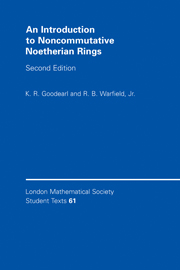Book contents
- Frontmatter
- Contents
- Introduction to the Second Edition
- Introduction to the First Edition
- Prologue
- 1 A Few Noetherian Rings
- 2 Skew Polynomial Rings
- 3 Prime Ideals
- 4 Semisimple Modules, Artinian Modules, and Torsionfree Modules
- 5 Injective Hulls
- 6 Semisimple Rings of Fractions
- 7 Modules over Semiprime Goldie Rings
- 8 Bimodules and Affiliated Prime Ideals
- 9 Fully Bounded Rings
- 10 Rings and Modules of Fractions
- 11 Artinian Quotient Rings
- 12 Links Between Prime Ideals
- 13 The Artin-Rees Property
- 14 Rings Satisfying the Second Layer Condition
- 15 Krull Dimension
- 16 Numbers of Generators of Modules
- 17 Transcendental Division Algebras
- Appendix. Some Test Problems for Noetherian Rings
- Bibliography
- Index
10 - Rings and Modules of Fractions
Published online by Cambridge University Press: 11 November 2010
- Frontmatter
- Contents
- Introduction to the Second Edition
- Introduction to the First Edition
- Prologue
- 1 A Few Noetherian Rings
- 2 Skew Polynomial Rings
- 3 Prime Ideals
- 4 Semisimple Modules, Artinian Modules, and Torsionfree Modules
- 5 Injective Hulls
- 6 Semisimple Rings of Fractions
- 7 Modules over Semiprime Goldie Rings
- 8 Bimodules and Affiliated Prime Ideals
- 9 Fully Bounded Rings
- 10 Rings and Modules of Fractions
- 11 Artinian Quotient Rings
- 12 Links Between Prime Ideals
- 13 The Artin-Rees Property
- 14 Rings Satisfying the Second Layer Condition
- 15 Krull Dimension
- 16 Numbers of Generators of Modules
- 17 Transcendental Division Algebras
- Appendix. Some Test Problems for Noetherian Rings
- Bibliography
- Index
Summary
In the study of commutative rings, one meets rings of fractions early on, first as quotient fields of integral domains but later as a general construction method. Given a commutative ring R and a subset X of R, we want to find a “larger” ring in which the elements of X become units. First of all, since all products of elements of X would necessarily become units in the new ring, we may enlarge X and assume that X is multiplicatively closed and that 1 ∈ X. We then build a new ring RX−1 (often written RX in the commutative literature, but this notation can cause confusion later) as a set of fractions r/x, where r ∈ R and x ∈ X. There must be an equivalence relation on these fractions, and the situation is made slightly more complex by the fact that X may contain zero-divisors, in which case the map R → RX−1 taking r to r/1 is not injective. The correct equivalence relation turns out to be the following: We say that r/x and r′/x′ define the same element of RX−1 if and only if (rx′ − r′x)y = 0 for some y ∈ X. Some easy calculations show that we can define a ring RX−1 in this way.
- Type
- Chapter
- Information
- An Introduction to Noncommutative Noetherian Rings , pp. 166 - 186Publisher: Cambridge University PressPrint publication year: 2004

